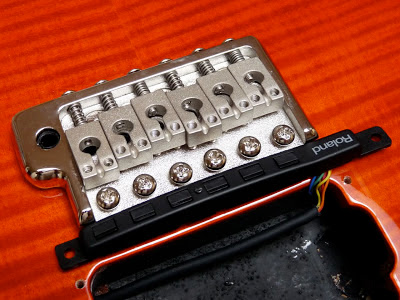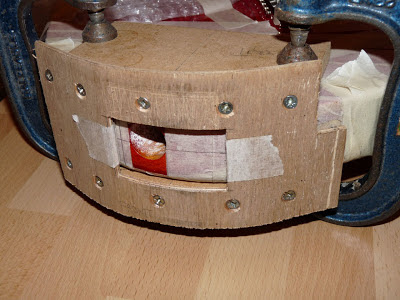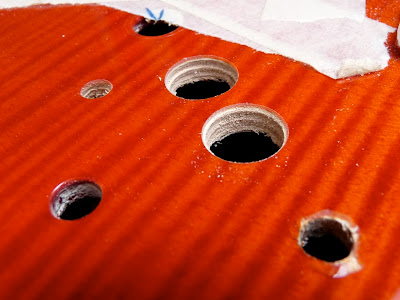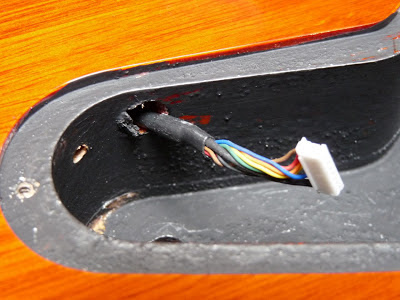This will be my third Roland GT3 pickup kit install. The Epiphone SG was the first and worked out OK. The Ibanez RG was the first time I took a router to what was, essentially, a new guitar and was a very neat install. The PRS was brand new (I bought it 4 weeks previously) and had a high gloss finish so it was a new challenge. I've tried to add a bit more detail in describing this installation and some of the points that need to be considered whichever guitar you end up choosing. This page is a bit more wordy than previous ones as I jotted down the details whilst I did each stage of the installation. I reckon this will be the last one I do for a while so wanted to capture everything, including some of the thought processes, I went through.
SELECTING THE GUITAR
 |
| The original PRS SE Custom 24 - in orange |
Why choose this guitar - it's a good balance between cost , build quality and playability. At the level at which I play I have no need for a 3 grand, or upwards, Les Paul and even if I did I think it unlikely that I would take the plunge and fit a Roland pickup so this PRS budget model meets all my requirements including 24 frets, a whammy bar and a very nice neck/action. If I screw up during the installation I haven't lost a huge amount. This guitar will be used mainly for driving a Roland GR-55 and a Roland GR-33 through a US-20 so the sounds from the conventional pick-ups are not the main priority. Having said that both the PRS and the Ibanez sound good as straight guitars.
HOW EASILY CAN THE PICKUP BE FITTED?
If you are adding a Roland pickup you could have it done professionally and I'd recommend that's the way to go if you are thinking of modifying a much loved guitar. I prefer to do it myself as I can make any last minute changes in positioning switches etc.
 |
| The Roland pickup fits between the bridge and the bridge pick-up |
Ideally you would take off the backplates and the jack socket mount to have a look at the cavities to see if there is sufficient room for the switches, sockets and circuit board. I think it's unlikely that your local guitar shop will allow you to do that but they may have a guitar tech on site who has already carried out a similar installation on your chosen guitar. Failing that do a search on the internet to see if anyone else has tried it or ask a question on the VGuitar Forum.
If you are considering modifying a guitar which has all it's wiring mounted on the scratchplate it is essential you have a look at the cavity to assess if everything will fit or how much enlarging work you will need to do on the cavity. You may also have a problem fitting all the controls without having to make a new scratchplate. I've not tried making one but I'm told it's very difficult to get a professional looking edge without using a router.
For this PRS the bare minimum of work that you would need to do would be - drilling the control switch holes, enlarging the hole for the socket and soldering some switch connections. Routing is optional.
BEFORE STARTING INSTALLATION
Before you start the installation take photographs and draw up a wiring diagram so you can put it all back together again if required. Plan out exactly where everything is going to be positioned and draw up a template. Work out best location for the two push button switches, the toggle that selects guitar, synth or both and the synth volume control. Decide whether you want to install the LED. It doesn't do anything except light up when connected to a powered up GR device.
I didn't want to end up having to rout larger control cavities and making new backplates so I positioned the new controls in such a way that they would fit within the existing cavity. It did mean that I had to compromise on the spacing of the switches but I felt that it was a reasonable trade-off against making the installation a lot easier. You need to remember not to position the switches too close to the cavity edges otherwise you might end up having to do some extra trimming away. To ensure they would fit I cut a piece of card which fitted exactly inside the cavity and then used it to mark out the positions.
 |
| Template for installing the new controls |
OUTPUT PLATE
I like a combined output plate. By having the two sockets mounted side-by-side it makes it easier if you want to run two cables together - a 13 way + conventional jack lead. An output from guitar pickup can be taken from back of the GR unit but the signal passes through some circuitry and the consensus of opinion on the VGuitar Forum is if you want a straight guitar output run a separate lead from the guitar's standard jack socket.
 |
| Combined output plate |
The mounting plate for the 13 pin socket that comes with the Roland kit is drilled so that the pcb is mounted parallel to the guitar body. I have found it easier to turn the socket through 90 degrees, as shown above, as it allows the two sockets to be mounted closer together.
ROUTING
If you are prepared to mount the output plate proud on the body then you do not need to do any routing, so skip to the next section.
Being a set neck mean it's more awkward to handle the guitar whilst routing and drilling so I wrapped it up well to prevent damage.
I used the guide I made for the Ibanez install, took it apart and re-cut the sides to match the body shape of the PRS. Before clamping the guide onto the guitar I made sure that the body was well protected with masking tape.
 |
| Routing guide clamped in position |
 |
| Underside of router showing collar around bit |
 |
| Underneath of the guide showing the packing pieces |
When routing the inset I did several runs with the router, increasing the depth slightly each time, until it was deep enough that the plate is flush with the body.
ENLARGING THE HOLE FOR THE SOCKETS
With the routing completed I set about enlarging the jack socket hole to accommodate the two sockets. The plastic jack socket will fit into a 22mm hole so the first action was to drill this hole using a flat wood bit next to the existing hole.
 |
| First stage in enlarging the hole through the body |
This time I decided to try a different approach so sharpened up my chisels and used them to carefully pare away the rest of the hole so that the sockets, mounted on the output plate, slotted neatly into the hole and that the plate would sit flush with the guitar edge. Using chisels enabled me to be far more controlled than with the rotary file and the body wood carved very easily. I will certainly use this method again.
 |
| The enlarged hole to take the two output sockets |
FITTING THE SWITCHES
The biggest challenge with this guitar was stopping the high gloss finish from cracking around the drilled holes. Masking tape alone is usually not enough. You can make up a template in MDF and clamp it tightly in place then drill through that. The fallback position if your do damage the surface finish is to fix a thin scratch plate over the area and make it look like that's what you intended all along. This can also be the solution if you decide to remove the Roland pick-up at some stage and you would be left with a guitar full of redundant holes.
The first hole I drilled was a 6mm one for the mini toggle switch. I decided to try it with just masking tape but used a bit designed specifically for wood and was surprised that it gave a nice clean cut through the gloss finish. I then tried an 8mm hole using a conventional HSS drill but that was not a success and the finish started to crack. Because it was for the guitar tone control I knew that the nut on the potentiometer, mounted with a washer under it, would mask the damage and stop the finish coming away any further. The knob also masks the area. The last two holes were for the S1/S2 up/down switches which are push fit. They require the largest holes of all - 15mm. For these I drilled an 8mm hole using a wood bit and then carefully enlarged them to the required size using a conical rotary file. The rotary action leaves a smooth finish around the hole and any small imperfections are masked by the lip around the switches. If you are using a rotary file then don't try and get to the finished size in one go. As you approach the correct diameter offer up the switches to see if they will fit. You don't want to end up with a hole that is too large and the switches rattling.
 |
| Control switch holes - note damage to finish around front one |
Once all the switches had been installed it was time to make the connections. Depending upon your soldering skills you may decide it's easier to connect the components before fitting them into the cavity. Some of the connections are terminated in mulit-way sockets but the ends to be soldered are stripped back/tinned ready but are a bit on the long side. For neatness you might decide to trim them back but I tend to leave them as they are as there is plenty of room in the cavity to accommodate them as they are and once the backplate is fitted you should not need to disturb them again.
 |
| Switches in position and the soldered wiring complete (except pickups) |
 |
| Hard wiring completed and pcb plugged in |
FITTING THE PICK-UP UNIT
One area that can cause difficulties is how to route the cable from the GK into the control cavity. The cable has a multiway plug on the end of it and whilst it is possible to fold the cable so the plug runs parallel, it still requires quite a large hole to pass through. As a last resort you could unsolder the plug, pass the cable through a much smaller hole, and then resolder. I haven't tried it so don't know how difficult that would be. If you choose this way then make sure you draw a diagram and take a picture of the connections. Luckily on this PRS the existing hole that takes the conventional pick-up leads is just big enough for the plug to pass through.
 |
| The output cable from the GK has a multi-way connector on the end |
 |
| The multi-way cable fed through the pick-up cavity |
 |
| Pick-up surround notched to allow multi-way cable to pass into the cavity |
To ensure that the GK was correctly lined up I restrung the guitar and moved the GK until it was exactly symmetrical with the strings, then marked the two mounting hole positions. I drilled two 1.5mm holes, then increased the bit to 2.5mm and finally used a 3.0mm for the first 15mm of the hole. By gradually increasing the bit size I was able to drill the holes without damaging the surface finish.
(When fixing the pick-up into position the easiest way is too simply screw the two support screws directly into the body. The "Rolls Royce" way to do it would be to install two, small, threaded bushes into the body and then use small bolts to hold the pick-up in position or you could make a thin plate that fits under the rear pick-up bezel. I chose the simple method)
To keep the GK at the correct height Roland include two springs, about 25mm long, which fit over the mounting screws, between the GK and the guitar body. They were too long for this installation so I cut them in half and that was just right.
Installation complete. I couldn't find any suitable knobs so took them off of my Ibanez as a temporary measure. I quite like the chrome look so will have to search round to get some more, maybe be a little smaller though.
Ready for testing! Plug the GK cable into the GR-55 and see what happens. All as it should be so time to put all the tools away and play.
Here's the finished guitar. I reckon it looks pretty neat and would recommend it as a "not too difficult" project.
 |
| The finished guitar |
No comments:
Post a Comment